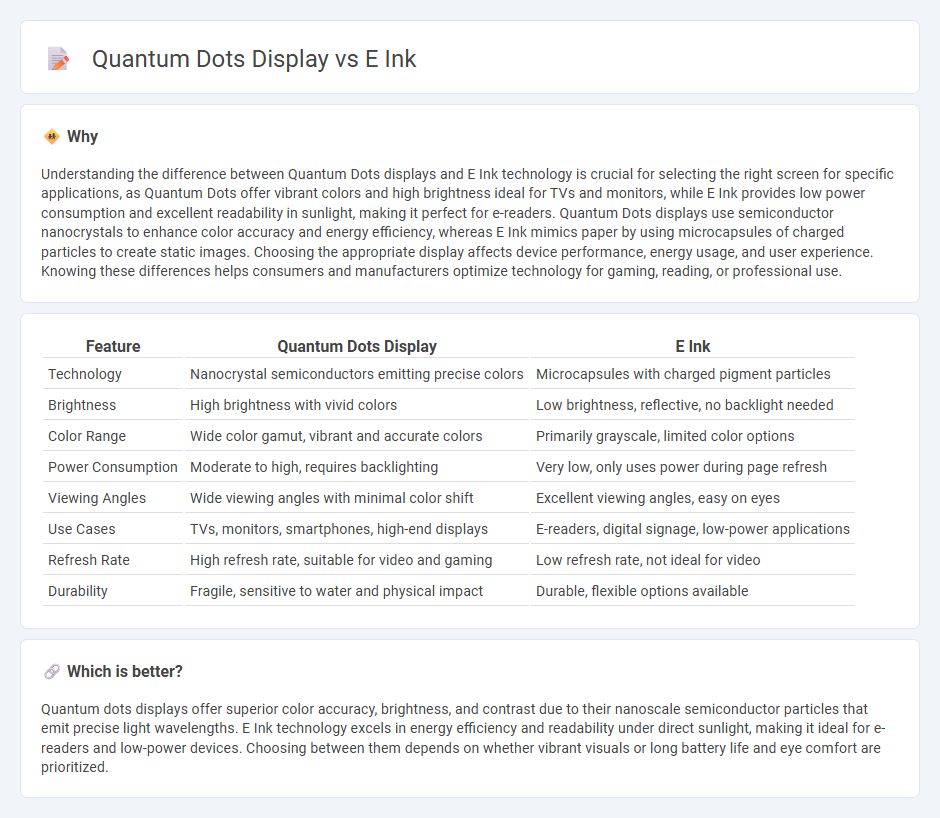
Quantum dots display technology delivers vibrant, high-contrast visuals with superior color accuracy and brightness, making it ideal for modern TVs and monitors. E Ink technology, favored in e-readers, offers low power consumption and excellent readability under direct sunlight, mimicking paper-like displays. Explore the differences in performance and applications between these two innovative display technologies.
Why it is important
Understanding the difference between Quantum Dots displays and E Ink technology is crucial for selecting the right screen for specific applications, as Quantum Dots offer vibrant colors and high brightness ideal for TVs and monitors, while E Ink provides low power consumption and excellent readability in sunlight, making it perfect for e-readers. Quantum Dots displays use semiconductor nanocrystals to enhance color accuracy and energy efficiency, whereas E Ink mimics paper by using microcapsules of charged particles to create static images. Choosing the appropriate display affects device performance, energy usage, and user experience. Knowing these differences helps consumers and manufacturers optimize technology for gaming, reading, or professional use.
Comparison Table
| Feature | Quantum Dots Display | E Ink |
|---|---|---|
| Technology | Nanocrystal semiconductors emitting precise colors | Microcapsules with charged pigment particles |
| Brightness | High brightness with vivid colors | Low brightness, reflective, no backlight needed |
| Color Range | Wide color gamut, vibrant and accurate colors | Primarily grayscale, limited color options |
| Power Consumption | Moderate to high, requires backlighting | Very low, only uses power during page refresh |
| Viewing Angles | Wide viewing angles with minimal color shift | Excellent viewing angles, easy on eyes |
| Use Cases | TVs, monitors, smartphones, high-end displays | E-readers, digital signage, low-power applications |
| Refresh Rate | High refresh rate, suitable for video and gaming | Low refresh rate, not ideal for video |
| Durability | Fragile, sensitive to water and physical impact | Durable, flexible options available |
Which is better?
Quantum dots displays offer superior color accuracy, brightness, and contrast due to their nanoscale semiconductor particles that emit precise light wavelengths. E Ink technology excels in energy efficiency and readability under direct sunlight, making it ideal for e-readers and low-power devices. Choosing between them depends on whether vibrant visuals or long battery life and eye comfort are prioritized.
Connection
Quantum dots displays and E Ink technology are connected through their use in advanced display systems aiming for high energy efficiency and superior visual quality. Quantum dots enhance color accuracy and brightness in LCD screens by emitting precise wavelengths of light, while E Ink employs microcapsules of charged particles to create bistable, low-power monochrome or color displays ideal for e-readers and low-energy signage. Both technologies represent innovations in display engineering focused on reducing energy consumption and improving user readability under various lighting conditions.
Key Terms
Electrophoretic Display
Electrophoretic display (EPD) technology, used in E Ink screens, relies on microcapsules containing charged pigment particles that move in response to an electric field, creating sharp, high-contrast images ideal for low power consumption and readability in direct sunlight. Quantum dots displays, by contrast, utilize semiconductor nanocrystals to emit precise colors with enhanced brightness and color accuracy, but typically consume more energy and suit vibrant multimedia applications rather than e-reader devices. Explore further to understand the advantages and applications of Electrophoretic Display in comparison to Quantum dots technology.
Quantum Dot Nanocrystals
Quantum dot nanocrystals offer superior color accuracy and brightness compared to E Ink displays, utilizing semiconductor particles that emit precise wavelengths of light when excited. Unlike E Ink's reflective technology optimal for low power consumption and readability in direct sunlight, quantum dots enhance LCD and OLED screens by improving color gamut and energy efficiency. Explore how quantum dot nanocrystals revolutionize modern display technologies and their innovative applications.
Color Gamut
E Ink displays offer limited color gamut primarily due to their electrophoretic technology, which restricts vibrant color reproduction when compared to Quantum dots displays known for their wide color gamut exceeding 90% DCI-P3. Quantum dots enhance color accuracy and brightness by emitting pure monochromatic red, green, and blue light, resulting in vivid and lifelike images ideal for high-end monitors and TVs. Explore deeper insights on how color gamut impacts display technology performance and user experience.
Source and External Links
E Ink - E Ink is a brand of electronic paper (e-paper) display technology known for its low power consumption and versatility in devices like e-readers and smartwatches.
E Ink - E Ink is a leading provider of ePaper technology, offering various products that enhance user experience while providing environmental benefits through low power consumption.
This Open-Source E-Ink Screen Is My Favorite New Gadget - This video showcases an open-source e-ink screen used in a customizable dashboard, highlighting its benefits and versatility.
 dowidth.com
dowidth.com